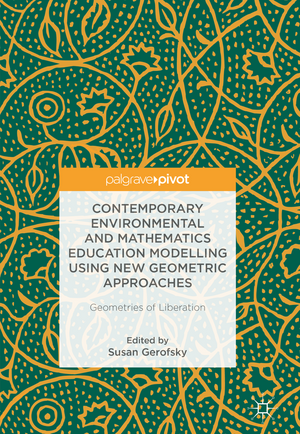Contemporary Environmental and Mathematics Education Modelling Using New Geometric Approaches: Geometries of Liberation
Editat de Susan Gerofskyen Limba Engleză Hardback – 20 iul 2018
Preț: 420.40 lei
Nou
Puncte Express: 631
Preț estimativ în valută:
80.45€ • 83.11$ • 66.96£
80.45€ • 83.11$ • 66.96£
Carte tipărită la comandă
Livrare economică 26 martie-09 aprilie
Preluare comenzi: 021 569.72.76
Specificații
ISBN-13: 9783319725222
ISBN-10: 331972522X
Pagini: 137
Ilustrații: XIII, 132 p. 23 illus., 21 illus. in color.
Dimensiuni: 148 x 210 mm
Greutate: 0.4 kg
Ediția:1st ed. 2018
Editura: Springer International Publishing
Colecția Palgrave Pivot
Locul publicării:Cham, Switzerland
ISBN-10: 331972522X
Pagini: 137
Ilustrații: XIII, 132 p. 23 illus., 21 illus. in color.
Dimensiuni: 148 x 210 mm
Greutate: 0.4 kg
Ediția:1st ed. 2018
Editura: Springer International Publishing
Colecția Palgrave Pivot
Locul publicării:Cham, Switzerland
Cuprins
1. Introduction: Geometries of Liberation.- 2. Shaped by the Places We Reason? Contrasting the Rectilinearity of Western Educational Thought with Other Possibilities.- 3. Ecofractal Poetics: Five Fractal Geometries for Creative, Sustainable, and Just Educational Design.- 4. Always an Abundance: Interstitial/Liminal Space, Time, and Resources that Are Invisible to the Grid.- 5. The Curricular Geometries of *SAMBA* Schools: Fractal Dimensions, Surface, Depth, and Recursion.- 6. Of Grids and Gardens: School Gardening and the Unsettling Attachments of Teaching Beside the Grid.- 7. Off the Grid.
Notă biografică
Susan Gerofsky is Assistant Professor in the Department of Curriculum and Pedagogy at the University of British Columbia, Canada.
Textul de pe ultima copertă
This book takes a fresh approach to using educational tools to solve profound problems in societies. The authors bring perspectives from curriculum studies, mathematics education, environmental education, and Indigenous epistemologies to a new consideration of “geometries to think with”. These tools reveal the wealth of resources and interrelationships in our world that have the potential to reconfigure and revitalize education. The transdisciplinary nature of the chapters and authors emphasizes the need for thinking beyond boundaries, while respecting the wisdom inherent in intellectual disciplines and traditions.
Caracteristici
Examines some of the ways geometries continue to shape the sensibilities, practices and structures of much of educational discourse, in spite of the well-developed critiques of their associated logics Interrogates geometries we use to frame our thinking and offers fresh approaches of the state of environmental education and curriculum currently on offer Explores the use of fractal patterns to spark group creative collaboration for sustainability education design and liberate learners and learning systems using a Transdisciplinary Regenerativity Index developed by synthesizing over thirty theorists’ work on regenerative design across fields and used as an assessment tool for group work
